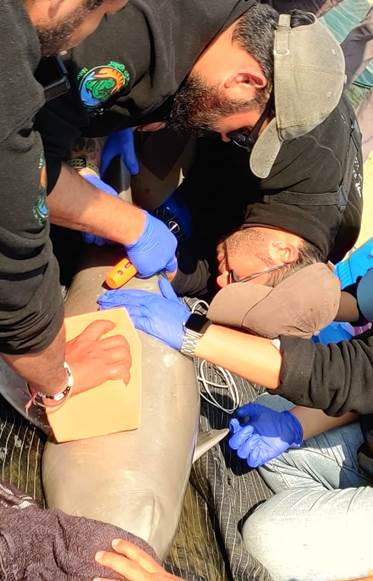Ministry of Environment, Forest and Climate Change
India Conducts First-ever Ganges River Dolphin Tagging in Assam
The historic milestone will deepen understanding of conserving our National Aquatic Animal: Shri Bhupender Yadav
प्रविष्टि तिथि:
18 DEC 2024 9:07PM by PIB Delhi
Today marks a historic achievement in wildlife conservation as the first-ever Ganges River Dolphin (Platanista gangetica) has been tagged in Assam. This initiative, conducted under the auspices of the Ministry of Environment, Forest and Climate Change (MoEFCC), was implemented by the Wildlife Institute of India (WII) in collaboration with the Assam Forest Department and Aaranyak, with funding from the National CAMPA Authority. This is the first tagging, not only in India, but also for the species, and this milestone is a significant advancement of Project Dolphin, under the visionary leadership of Prime Minister Shri Narendra Modi.

Given the paucity of information on Ganges River Dolphin habitat needs, movement pattern or home-range information, it was decided to undertake satellite tagging of dolphins in it’s distribution range. The first of the tagging took place in Assam, where a healthy male river dolphin was tagged and released under utmost veterinary care. The tagging exercise will help in understanding their seasonal and migratory patterns, range, distribution, and habitat utilization, particularly in fragmented or disturbed river systems.

In a post on social media, Union Minister for Environment, Forest and Climate Change, Shri Bhupender Yadav said, “Happy to share the news of the first-ever tagging of Ganges River Dolphin in Assam—a historic milestone for the species and India! This MoEFCC and National CAMPA-funded project, led by the Wildlife Institute of India in collaboration with Assam Forest Dept and Aaranyak, will deepen our understanding of conserving our National Aquatic Animal.”
The Ganges River Dolphin, India’s National Aquatic Animal, is unique in its ecology, being nearly blind and relying on echolocation for its biological needs. Approximately 90% of the species' population resides in India, historically distributed across the Ganga-Brahmaputra-Meghna and Karnaphuli river systems. However, its distribution has drastically declined over the past century. Despite its wide range, significant knowledge gaps remain regarding this species due to its elusive behaviour. It surfaces for only 5-30 seconds at a time, posing a significant challenge in understanding the ecological needs of the species and for any scientifically sound conservation interventions.

Under the umbrella of Project Dolphin, the MoEFCC has funded through National CAMPA Authority, Wildlife Institute of India, to undertake comprehensive range-wide research to develop conservation action plan, and fill existing knowledge gaps for the long-term conservation of the species. Given that Ganges River Dolphins are apex predators, and serve as umbrella species for the river systems, it is important to ensure their well-being, as it will ensure of the sustenance of the entire river ecosystem.
Director, WII, Shri Virendra R. Tiwari said, “Tagging River Dolphins will contribute to evidence-based conservation strategies that are urgently needed for this species. I am delighted that this historic step has been undertaken”.

Project investigator Dr. Vishnupriya Kolipakam emphasized, “This is a significant advancement in understanding the ecological needs of river dolphins, which will help conserve critical habitats within these vast river ecosystems. This is vital not only for aquatic biodiversity but also for sustaining thousands of people who depend on these resources.”

The tagging was made possible by advancements in technology; the lightweight tags emit signals compatible with Argos satellite systems even with limited surfacing time and are designed to minimize interference with dolphin movement. Plans are underway to extend this initiative to other states inhabited by Ganges River Dolphins to build a comprehensive understanding of their population dynamics and habitat requirements. This monumental effort underscores India’s unwavering commitment to wildlife conservation and sets a new benchmark in the protection of endangered species.
*****
VM
(रिलीज़ आईडी: 2085865)
आगंतुक पटल : 6062